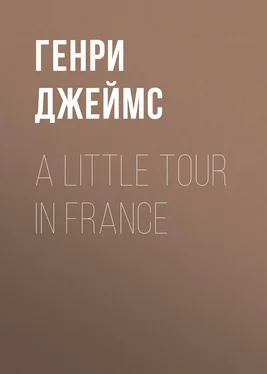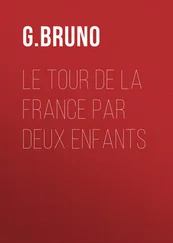Генри Джеймс - A Little Tour in France
Здесь есть возможность читать онлайн «Генри Джеймс - A Little Tour in France» — ознакомительный отрывок электронной книги совершенно бесплатно, а после прочтения отрывка купить полную версию. В некоторых случаях можно слушать аудио, скачать через торрент в формате fb2 и присутствует краткое содержание. Жанр: Путешествия и география, foreign_antique, foreign_prose, на английском языке. Описание произведения, (предисловие) а так же отзывы посетителей доступны на портале библиотеки ЛибКат.
- Название:A Little Tour in France
- Автор:
- Жанр:
- Год:неизвестен
- ISBN:нет данных
- Рейтинг книги:4 / 5. Голосов: 1
-
Избранное:Добавить в избранное
- Отзывы:
-
Ваша оценка:
- 80
- 1
- 2
- 3
- 4
- 5
A Little Tour in France: краткое содержание, описание и аннотация
Предлагаем к чтению аннотацию, описание, краткое содержание или предисловие (зависит от того, что написал сам автор книги «A Little Tour in France»). Если вы не нашли необходимую информацию о книге — напишите в комментариях, мы постараемся отыскать её.
A Little Tour in France — читать онлайн ознакомительный отрывок
Ниже представлен текст книги, разбитый по страницам. Система сохранения места последней прочитанной страницы, позволяет с удобством читать онлайн бесплатно книгу «A Little Tour in France», без необходимости каждый раз заново искать на чём Вы остановились. Поставьте закладку, и сможете в любой момент перейти на страницу, на которой закончили чтение.
Интервал:
Закладка:
IV
Your business at Tours is to make excursions; and if you make them all, you will be very well occupied. Touraine is rich in antiquities; and an hour's drive from the town in almost any direction will bring you to the knowledge of some curious fragment of domestic or ecclesiastical architecture, some turreted manor, some lonely tower, some gabled village, or historic site. Even, however, if you do everything, – which was not my case, – you cannot hope to relate everything, and, fortunately for you, the excursions divide them- selves into the greater and the less. You may achieve most of the greater in a week or two; but a summer in Touraine (which, by the way must be a charming thing) would contain none too many days for the others. If you come down to Tours from Paris, your best economy is to spend a few days at Blois, where a clumsy, but rather attractive little inn, on the edge of the river, will offer you a certain amount of that familiar and intermittent hospitality which a few weeks spent in the French provinces teaches you to regard as the highest attainable form of accommodation. Such an economy I was unable to practise. I could only go to Blois (from Tours) to spend the day; but this feat I accomplished twice over. It is a very sympathetic little town, as we say nowadays, and one might easily resign one's self to a week there. Seated on the north bank of the Loire, it presents a bright, clean face to the sun, and has that aspect of cheerful leisure which belongs to all white towns that reflect, themselves in shining waters. It is the water-front only of Blois, however, that exhibits, this fresh complexion; the in- terior is of a proper brownness, as befits a signally historic city. The only disappointment I had there was the discovery that the castle, which is the special object of one's pilgrimage, does not overhang the river, as I had always allowed myself to understand. It overhangs the town, but it is scarcely visible from the stream. That peculiar good fortune is reserved for Amboise and Chaurnont.
The Chateau de Blois is one of the most beautiful and elaborate of all the old royal residences of this part of France, and I suppose it should have all the honors of my description. As you cross its threshold, you step straight into the brilliant movement of the French Renaissance. But it is too rich to describe, – I can only touch it here and there. It must be pre- mised that in speaking of it as one sees it to-day, one speaks of a monument unsparingly restored. The work of restoration has been as ingenious as it is pro- fuse, but it rather chills the imagination. This is perhaps almost the first thing you feel as you ap- proach the castle from the streets of the town. These little streets, as they, leave the river, have pretensions to romantic steepness; one of them, indeed, which resolves itself into a high staircase with divergent wings (the escalier monumental ), achieved this result so successfully as to remind me vaguely – I hardly know why – of the great slope of the Capitol, beside the Ara Coeli, at Rome. The view of that part of the castle which figures to-day as the back (it is the only aspect I had seen reproduced) exhibits the marks of restoration with the greatest assurance. The long facade, consisting only of balconied windows deeply recessed, erects itself on the summit of a considerable hill, which gives a fine, plunging movement to its foundations. The deep niches of the windows are all aglow with color. They have been repainted with red and blue, relieved with gold figures; and each of them looks more like the royal box at a theatre than like the aperture of a palace dark with memories. For all this, however, and in spite of the fact that, as in some others of the chateaux of Touraine, (always excepting the colossal Chambord, which is not in Touraine!) there is less vastness than one had expected, the least hospitable aspect of Blois is abundantly impressive. Here, as elsewhere, lightness and grace are the key- note; and the recesses of the windows, with their happy proportions, their sculpture, and their color, are the empty frames of brilliant pictures. They need the figure of a Francis I. to complete them, or of a Diane de Poitiers, or even of a Henry III. The base of this exquisite structure emerges from a bed of light verdure, which has been allowed to mass itself there, and which contributes to the springing look of the walls; while on the right it joins the most modern portion of the castle, – the building erected, on founda- tions of enormous height and solidity, in 1635, by Gaston d'Orleans. This fine, frigid mansion – the proper view of it is from the court within – is one of the masterpieces of Francois Mansard, whom. a kind pro- vidence did not allow to make over the whole palace in the superior manner of his superior age. This had been a part of Gaston's plan, – he was a blunderer born, and this precious project was worthy of him. This execution of it would surely have been one of the great misdeeds of history. Partially performed, the misdeed is not altogether to be regretted; for as one stands in the court of the castle, and lets one's eye wander from the splendid wing of Francis I. – which is the last work of free and joyous invention – to the ruled lines and blank spaces of the ponderous pavilion of Mansard, one makes one's reflections upon the advantage, in even the least personaI of the arts, of having something to say, and upon the stupidity of a taste which had ended by becoming an aggregation of negatives. Gaston's wing, taken by itself, has much of the bel air which was to belong to the architecture of Louis XIV.; but, taken in contrast to its flowering, laughing, living neighbor, it marks the difference be- tween inspiration and calculation. We scarcely grudge it its place, however, for it adds a price to the rest of the chateau.
We have entered the court, by the way, by jump- ing over the walls. The more orthodox method is to follow a modern, terrace, which leads to the left, from the side of the chateau that I began by speaking of, and passes round, ascending, to a little square on a considerably higher level, which is not, like a very modern square on which the back (as I have called it) looks out, a thoroughfare. This small, empty place, oblong in form, at once bright and quiet, with a cer- tain grass-grown look, offers an excellent setting to the entrance-front of the palace, – the wing of Louis XII. The restoration here has been lavish; but it was per- haps but an inevitable reaction against the injuries, still more lavish, by which the unfortunate building had long been overwhelmed. It had fallen into a state of ruinous neglect, relieved only by the misuse pro- ceeding from successive generations of soldiers, for whom its charming chambers served as barrack-room. Whitewashed, mutilated, dishonored, the castle of Blois may be said to have escaped simply with its life. This is the history of Amboise as well, and is to a certain extent the history of Chambord. Delightful, at any rate, was the refreshed facade of Louis XII. as I stood and looked at it one bright September morning. In that soft, clear, merry light of Touraine, everything shows, everything speaks. Charming are the taste, the happy proportions, the color of this beautiful front, to which the new feeling for a purely domestic architec- ture – an architecture of security and tranquillity, in which art could indulge itself – gave an air of youth and gladness. It is true that for a long time to come the castle of Blois was neither very safe nor very quiet; but its dangers came from within, from the evil passions of its inhabitants, and not from siege or in- vasion. The front of Louis XII. is of red brick, crossed here and there with purple; and the purple slate of the high roof, relieved with chimneys beautifully treated, and with the embroidered caps of pinnacles and arches, with the porcupine of Louis, the ermine and the festooned rope which formed the devices of Anne of Brittany, – the tone of this rich-looking roof carries out the mild glow of the wall. The wide, fair windows look as if they had expanded to let in the rosy dawn of the Renaissance. Charming, for that matter, are the windows of all the chateaux of Touraine, with their squareness corrected (as it is not in the Tudor architecture) by the curve of the upper corners, which makes this line look – above the expressive aperture – like a pencilled eyebrow. The low door of this front is crowned by a high, deep niche, in which, under a splendid canopy, stiffly astride of a stiffly draped charger, sits in profile an image of the good King Louis. Good as he had been, – the father of his people, as he was called (I believe he remitted various taxes), – he was not good enough to pass muster at the Revolution; and the effigy I have just described is no more than a reproduction of the primitive statue demolished at that period.
Читать дальшеИнтервал:
Закладка:
Похожие книги на «A Little Tour in France»
Представляем Вашему вниманию похожие книги на «A Little Tour in France» списком для выбора. Мы отобрали схожую по названию и смыслу литературу в надежде предоставить читателям больше вариантов отыскать новые, интересные, ещё непрочитанные произведения.
Обсуждение, отзывы о книге «A Little Tour in France» и просто собственные мнения читателей. Оставьте ваши комментарии, напишите, что Вы думаете о произведении, его смысле или главных героях. Укажите что конкретно понравилось, а что нет, и почему Вы так считаете.












